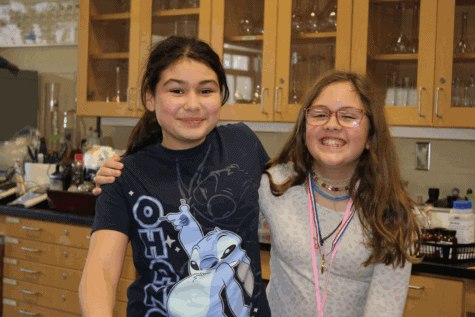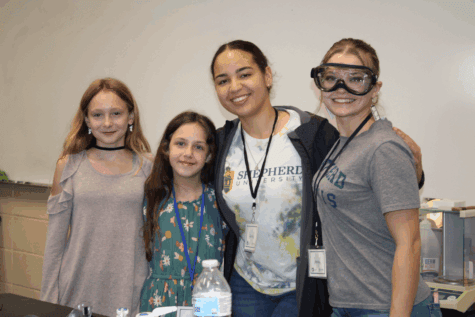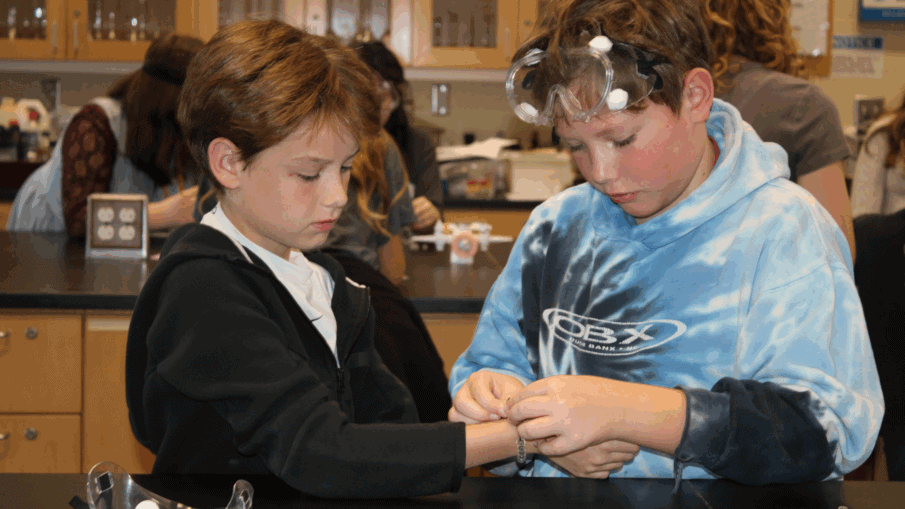Shepherd University hosted the 12th annual Seeding Your Future Conference on Saturday, Nov. 8, an event designed to spark middle school students’ curiosity in science, technology, engineering, and mathematics through hands-on workshops led by Shepherd faculty, students, and community partners.
Funded by NASA’s West Virginia Space Grant Consortium and Shepherd University, the conference invited fifth-through eighth-grade students from across the region to spend the day exploring science in an engaging and supportive environment.
“Our main goal is that no matter what state they came in —interested in STEM, no interest, lots of interest —they leave with more interest,” said co-organizer Dr. Jacquelyn Cole, associate professor of chemistry. “We want them to feel comfortable and confident that they can do science and maybe discover what kind of science they would like to do.”
The Seeding Your Future Conference was founded in 2014 by Dr. Sytil Murphy, associate professor of physics, and Dr. Jordan Mader, who is now at the University of Arkansas. The idea grew from the national program Expanding Your Horizons, which Murphy attended during graduate school and wanted to adapt for the Shepherd community.
“There are similar programs in bigger cities like Baltimore and D.C.,” Murphy said. “I thought, why can’t we do something like that here, but make it ours?”
Murphy and Cole are currently organizing the event alongside Dr. Lindsey Levitan, assistant professor of biology.

Originally, the conference focused specifically on middle school girls, addressing what Murphy described as a “leaky pipeline,” where girls often lose confidence in STEM subjects during adolescence.
“We wanted to put a bandage around that pipeline,” Murphy explained. “Over time, parents of boys began reaching out, and we realized the need to open it up to everyone.”
Today, the event is co-ed, welcoming all middle school students while continuing to support girls’ participation in STEM.
“We’re still having the impact we wanted to have on girls,” Cole said. “But now we’re reaching even more students who might not have had this kind of exposure otherwise.”
Throughout the day, students rotated through a series of creative and interactive workshops that blended science with imagination. Activities included pond water organism bingo, building anatomically correct insects out of building bricks, constructing an eagle’s nest out of pool noodles, simulating the effects of oil spills on bird feathers, coding with artificial intelligence and more.
“If you can think of it, we’ve probably done it,” Murphy said. “We’ve had workshops on music, art, physics, chemistry —you name it. We want students to see that science connects to everything.”
Cole said that Seeding Your Future encourages faculty and staff across the university to participate by sharing the science behind their interests or hobbies. “If you love something and you can connect it to science, teach it,” Cole said. “That’s how we show students that science is everywhere.”
Dozens of Shepherd student volunteers helped guide participants between workshops, set up materials, and assist faculty presenters.
“The students are the ones who really keep things running smoothly,” Murphy said. “They don’t have to be science majors, they just have to be friendly, reliable, and know their campus.”
Like many outreach programs, Seeding Your Future faces challenges in reaching new audiences. Murphy explained that changes in public school communication systems have made it more difficult to distribute flyers directly to students, while family schedules often compete with other extracurricular activities.

“It’s not as easy as it used to be to reach kids,” Murphy said. “But with help from Shepherd’s Provost Office and University Communications, we’re finding new ways to grow.”
The organizers said that increased university support will help strengthen marketing through social media, local news outlets, and partnerships with area schools.
Over the years, the conference has made a lasting impression on many students. Murphy said several participants later chose to attend Shepherd University — some even enrolling in STEM programs.
“We’ve had at least five students that we know of who came to Shepherd after participating in the conference,” Murphy said. “It’s proof that experiences like this stick with them.”
The organizers are also developing a new project called “Grab a Lab in a Tote Box,” which will allow teachers and community groups to check out portable STEM kits for classroom use.
“It’s like a science library,” Murphy said. “Teachers or Scout leaders can borrow a kit, run an experiment with their group, and then bring it back. It’s another way to get hands-on science into the community.”
Now in its 12th year, Seeding Your Future continues to grow as a cornerstone of Shepherd’s outreach mission, helping local students connect with the excitement of discovery.
“Every year there’s a new hurdle, and every year we overcome it,” Cole said. “But at the end of the day, seeing those students light up when they realize they can do this, that’s why we keep doing it.”

Leave a Reply